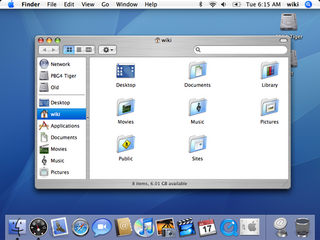Related Research Articles
QuickTime is a discontinued extensible multimedia architecture created by Apple, which supports playing, streaming, encoding, and transcoding a variety of digital media formats. The term QuickTime also refers to the QuickTime Player front-end media player application, which is built-into macOS, and was available for download on Windows until 2016.
TextEdit is an open-source word processor and text editor, first featured in NeXT's NeXTSTEP and OPENSTEP. It is now distributed with macOS since Apple Inc.'s acquisition of NeXT, and available as a GNUstep application for other Unix-like operating systems such as Linux. It is powered by Apple Advanced Typography.
Cocoa is Apple's native object-oriented application programming interface (API) for its desktop operating system macOS.
Carbon was one of two primary C-based application programming interfaces (APIs) developed by Apple for the macOS operating system. Carbon provided a good degree of backward compatibility for programs that ran on Mac OS 8 and 9. Developers could use the Carbon APIs to port (“carbonize”) their “classic” Mac applications and software to the Mac OS X platform with little effort, compared to porting the app to the entirely different Cocoa system, which originated in OPENSTEP. With the release of macOS 10.15 Catalina, the Carbon API was officially discontinued and removed, leaving Cocoa as the sole primary API for developing macOS applications.
AppleScript is a scripting language created by Apple Inc. that facilitates automated control over scriptable Mac applications. First introduced in System 7, it is currently included in all versions of macOS as part of a package of system automation tools. The term "AppleScript" may refer to the language itself, to an individual script written in the language, or, informally, to the macOS Open Scripting Architecture that underlies the language.

WebObjects was a Java web application server and a server-based web application framework originally developed by NeXT Software, Inc.
Xcode is Apple's integrated development environment (IDE) for macOS, used to develop software for macOS, iOS, iPadOS, watchOS, tvOS, and visionOS. It was initially released in late 2003; the latest stable release is version 14.3.1, released on June 1, 2023, and is available free of charge via the Mac App Store and the Apple Developer website. Registered developers can also download preview releases and prior versions of the suite through the Apple Developer website. Xcode includes command-line tools which enable UNIX-style development via the Terminal app in macOS. They can also be downloaded and installed without the GUI.

Mac OS X Tiger is the 5th major release of macOS, Apple's desktop and server operating system for Mac computers. Tiger was released to the public on April 29, 2005 for US$129.95 as the successor to Mac OS X 10.3 Panther. Some of the new features included a fast searching system called Spotlight, a new version of the Safari web browser, Dashboard, a new 'Unified' theme, and improved support for 64-bit addressing on Power Mac G5s. Mac OS X 10.4 Tiger offered a number of features, such as fast file searching and improved graphics processing, that Microsoft had spent several years struggling to add to Windows with acceptable performance.
The WASTE is an Apple Macintosh text editing software library. WASTE helps Macintosh programmers include advanced text display and editing in their applications.

XeTeX is a TeX typesetting engine using Unicode and supporting modern font technologies such as OpenType, Graphite and Apple Advanced Typography (AAT). It was originally written by Jonathan Kew and is distributed under the X11 free software license.
MacApp is the object oriented application framework for Apple Computer's discontinued classic Mac OS. Released in 1985, it transitioned from Object Pascal to C++ in 1991's version 3.0 release, which offered support for much of System 7's new functionality. MacApp was used for a variety of major applications, including Adobe Photoshop and SoftPress Freeway. Microsoft's MFC and Borland's OWL were both based directly on MacApp concepts.
Quartz Composer is a node-based visual programming language provided as part of the Xcode development environment in macOS for processing and rendering graphical data.
In the macOS, iOS, NeXTSTEP, and GNUstep programming frameworks, property list files are files that store serialized objects. Property list files use the filename extension .plist, and thus are often referred to as p-list files.
The Visual Component Framework (VCF) is an abandoned open source project for development under Microsoft Windows and Apple Macintosh that is distributed under the BSD license. It is an advanced C++ application framework that makes it easier to produce GUI-based C++ applications. The framework is C++ design and has built in support for rapid application development. The framework is designed to be portable over multiple platforms and compilers.
The Apple Developer Tools are a suite of software tools from Apple to aid in making software dynamic titles for the macOS and iOS platforms. The developer tools were formerly included on macOS install media, but are now exclusively distributed over the Internet. As of macOS 10.12, Xcode is available as a free download from the Mac App Store.
Core Text is a Core Foundation style API in macOS, first introduced in Mac OS X 10.4 Tiger, made public in Mac OS X 10.5 Leopard, and introduced for the iPad with iPhone SDK 3.2. Exposing a C API, it replaces the text rendering abilities of the now-deprecated QuickDraw and ATSUI frameworks in previous versions of Mac OS X. According to Apple, Core Text is "designed for high performance and ease of use" and its layout API is "simple, consistent, and tightly integrated with Core Foundation, Core Graphics, and Cocoa."

Mono is a free and open-source .NET Framework-compatible software framework. Originally by Ximian, it was later acquired by Novell, and is now being led by Xamarin, a subsidiary of Microsoft and the .NET Foundation. Mono can be run on many software systems.
Swift is a high-level general-purpose, multi-paradigm, compiled programming language developed by Apple Inc. and the open-source community. First released in June 2014, Swift was developed as a replacement for Apple's earlier programming language Objective-C, as Objective-C had been largely unchanged since the early 1980s and lacked modern language features. Swift works with Apple's Cocoa and Cocoa Touch frameworks, and a key aspect of Swift's design was the ability to interoperate with the huge body of existing Objective-C code developed for Apple products over the previous decades. It was built with the open source LLVM compiler framework and has been included in Xcode since version 6, released in 2014. On Apple platforms, it uses the Objective-C runtime library, which allows C, Objective-C, C++ and Swift code to run within one program.
AVFoundation is a multimedia framework with APIs in Objective-C and Swift, which provides high-level services for working with time-based audiovisual media on Apple Darwin-based operating systems: iOS, macOS, tvOS, and watchOS. It was first introduced in iOS 4 and has seen significant changes in iOS 5 and iOS 6. Starting with Mac OS X Lion, it is now the default media framework for the macOS platform.
References
- ↑ "Guides and Sample Code". developer.apple.com. Retrieved 2018-03-20.
- ↑ Truta, Filip. "Apple Confirms Deprecation of ATS.framework in Xcode 4.6 Developer Preview 1". softpedia. Retrieved 2018-03-20.
- ↑ "Apple Developer Documentation". developer.apple.com. Retrieved 2022-10-04.